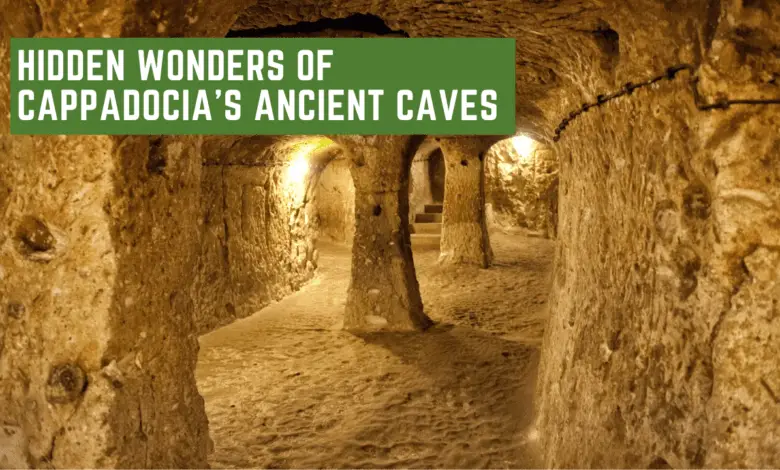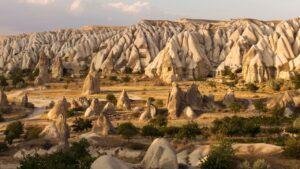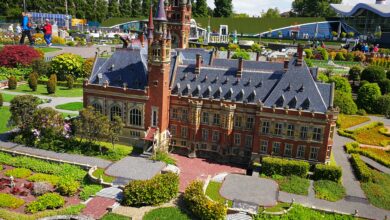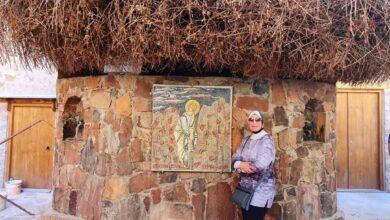🌄 Exploring the Hidden Wonders of Cappadocia’s Ancient Caves, Turkey 🕳️
Unearth the Mysteries of Turkey's Subterranean Marvels

Introduction
Nestled in the heart of Turkey lies a hidden treasure trove of history and natural wonder – the ancient caves of Cappadocia. These remarkable subterranean dwellings, carved into the soft volcanic rock of the region, have been a testament to human ingenuity for centuries.
In this blog post, we will embark on a journey beneath the surface to explore the rich history, unique architecture, and cultural significance of Cappadocia’s caves. From their origins as ancient homes to their evolution into modern-day attractions, the caves of Cappadocia are a testament to the enduring spirit of human innovation and adaptation.
A Geological and Historical Marvel
A Geological Formation of Cappadocia’s Soft Volcanic Rock
Cappadocia, located in central Turkey, is renowned for its breathtaking landscapes and unique geological formations, making it a geological and historical marvel. At the heart of this wonder lies the captivating story of the soft volcanic rock that has shaped the region’s character over millions of years.
The extraordinary geological features of Cappadocia result from the region’s history of volcanic activity. Around 60 million years ago, volcanic eruptions blanketed the area with layers of ash, tuff, and basalt. Over time, the soft tuff, which is a consolidated form of volcanic ash, eroded due to wind and water, creating the distinctive fairy chimneys, caves, and surreal rock formations that define Cappadocia’s landscape today.
This unique geological setting has not only fascinated geologists but has also played a crucial role in the region’s history, culture, and human habitation. Early inhabitants harnessed the malleable tuff rock for shelter and carved remarkable underground cities and cave dwellings.
Early Human Habitation in Cappadocia
Cappadocia boasts a rich history of human habitation dating back thousands of years. Evidence suggests that the region was first inhabited during the Paleolithic era, making it one of the earliest settled areas in the world. The unique geological features of Cappadocia, particularly the soft tuff rock, provided a natural canvas for human adaptation.
Throughout history, Cappadocia witnessed the rise and fall of various civilizations, including the Hittites, Phrygians, Persians, and Romans, all of whom left their marks on the landscape. The tuff rock’s malleability allowed ancient inhabitants to carve intricate underground cities and cave churches, creating an underground network that served as protection from invaders and harsh weather conditions.
Influence of Hittites and Phrygians
The Hittites and Phrygians, two of the most prominent civilizations in the region’s history, significantly influenced Cappadocia’s culture and heritage. The Hittites, known for their advanced metallurgy and fortifications, established their presence in Cappadocia around 1800 BC. Their influence is evident in the rock-carved fortresses and temples that dot the landscape.
The Phrygians, who arrived in Cappadocia around 1200 BC, brought their distinctive architectural style to the region. They crafted remarkable rock-cut tombs and monuments, adding to the mystique of Cappadocia’s geological wonders.
Role of Caves in Early Christianity
Cappadocia’s soft volcanic rock and cave systems also played a pivotal role in the early history of Christianity. During the Roman Empire’s persecution of Christians, many believers sought refuge in the underground cities and cave complexes of Cappadocia. These caves served as places of worship, hiding, and community for early Christians.
Notably, Cappadocia is home to the Göreme Open-Air Museum, a UNESCO World Heritage site, where visitors can explore ancient cave churches adorned with stunning frescoes, offering a glimpse into the early Christian heritage of the region.
Architectural Wonders of Cappadocia
Cappadocia, a region in central Turkey known for its surreal landscapes, isn’t just famous for its geological formations but also boasts a rich tapestry of architectural wonders that have left an indelible mark on history. From the innovative cave house designs to the breathtaking cave churches adorned with intricate frescoes, and the astonishing underground cities of Kaymaklı and Derinkuyu, Cappadocia’s architectural heritage is nothing short of mesmerizing.
Cave House Design and Layout
One of the most intriguing architectural marvels in Cappadocia is the cave house design and layout. Early inhabitants of the region harnessed the soft volcanic rock, or tuff, to create unique dwellings by carving into the rock. These cave houses were ingeniously designed, taking advantage of the rock’s natural insulating properties to maintain comfortable temperatures year-round.
The layout of these cave houses typically consisted of interconnected rooms carved into the rock, with carved shelves and niches for storage and sleeping quarters. Some cave houses even featured multi-level structures, with kitchens, living areas, and bedrooms seamlessly integrated into the rock face. The organic integration of these dwellings into the landscape reflects the resourcefulness and architectural ingenuity of Cappadocia’s early residents.
Elaborate Cave Churches and Frescoes
Cappadocia is renowned for its elaborate cave churches, which are not only architectural wonders but also hold immense historical and cultural significance. These cave churches were carved into the soft tuff rock, and their interiors were adorned with stunning frescoes that tell biblical stories and depict scenes from the life of Jesus Christ.
One of the most famous cave church complexes in Cappadocia is the Göreme Open-Air Museum, where visitors can explore a series of cave churches such as the Apple Church, Dark Church, and Snake Church. The frescoes inside these churches are remarkably well-preserved, despite the passage of centuries. The intricate artwork, with vibrant colors and detailed depictions, showcases the talent and dedication of the artisans who created them.
Underground Cities: Kaymaklı and Derinkuyu
Perhaps the most astonishing architectural wonders in Cappadocia are the underground cities of Kaymaklı and Derinkuyu. These subterranean complexes are a testament to human engineering and architectural innovation. Carved deep into the soft volcanic rock, these underground cities served as fortified refuges for the region’s inhabitants during times of invasion and persecution.
The underground cities feature a complex network of tunnels, chambers, storage rooms, and ventilation shafts that extended several stories below the surface. Ingenious design allowed for the provision of essential amenities, such as kitchens, churches, and even livestock stables, all hidden beneath the earth’s surface. These architectural marvels served not only as shelters but also as thriving communities with impressive engineering solutions to ensure survival in challenging times.

A Cultural Tapestry of Cappadocia
Cappadocia, with its geological wonders and rich history, weaves a vibrant cultural tapestry that continues to captivate visitors from around the world. This tapestry is composed of modern-day cave dwellings, dedicated tourism and preservation efforts, and the warm embrace of Cappadocian cuisine and hospitality. You can actually book hotels in Cappadocia Caves using Booking.com.
Modern-Day Cave Dwellings
While Cappadocia’s cave dwellings have ancient origins, they are very much a part of the region’s modern cultural landscape. Today, many residents still call these unique dwellings home. Modern-day cave houses have been adapted to meet contemporary needs while preserving the traditional charm and character of the past.
These cave houses offer a one-of-a-kind living experience, with their cool interiors in the scorching summers and cozy warmth during the harsh winters. Some have been transformed into boutique hotels, allowing visitors to immerse themselves in the history and culture of the region. The blend of ancient architectural techniques with modern amenities creates a living connection to Cappadocia’s past, making it an integral part of the cultural identity of the region.
Tourism and Preservation Efforts
Tourism plays a pivotal role in preserving and celebrating Cappadocia’s cultural heritage. The region’s unique geological formations, cave churches, and underground cities have made it a UNESCO World Heritage site and a must-visit destination for travelers.
Efforts to balance tourism with preservation have been instrumental in maintaining the authenticity of Cappadocia’s cultural treasures. Regulations and guidelines are in place to protect the delicate frescoes inside cave churches, ensuring that these priceless artworks continue to tell their stories for generations to come. Preservation initiatives also extend to the conservation of ancient cave dwellings and rock-cut architecture, ensuring that these remarkable structures remain part of Cappadocia’s living heritage.
Cappadocian Cuisine and Hospitality
Cappadocian cuisine and hospitality provide another layer to the region’s cultural tapestry. Traditional dishes such as manti (Turkish dumplings), testi kebab (pottery kebab), and gözleme (savory Turkish flatbreads) offer a tantalizing journey into the flavors of the region. These dishes are often served in family-run restaurants and homes, emphasizing the warm and welcoming nature of Cappadocian hospitality.
The region’s unique geography has also given rise to the production of exceptional wines, with vineyards scattered throughout the valleys. Visitors can indulge in wine tasting experiences, further enhancing their cultural immersion.
Cappadocian hospitality is legendary, with locals welcoming guests into their homes and offering insights into their way of life. Whether sharing a meal, engaging in a traditional tea ceremony, or participating in local festivals, visitors to Cappadocia are embraced by the warmth and friendliness of the people.
Frequently Asked Questions
Q: How can I visit the ancient caves of Cappadocia?
Visiting Cappadocia’s ancient caves is easy. You can join guided tours or explore independently. Just remember to respect the historical sites and follow local regulations.
Q: Are the caves safe to explore?
Yes, most of the caves open to tourists are safe to explore. However, it’s essential to take necessary precautions, such as wearing suitable footwear and following safety guidelines.
Q: Can you still see frescoes in the cave churches?
Absolutely! Many cave churches in Cappadocia still boast remarkably well-preserved frescoes that provide a glimpse into the region’s artistic and religious history.
Q: Are there any unique experiences offered in the cave hotels?
Yes, staying in a cave hotel is a unique experience. You’ll have the chance to sleep in a room carved into the rock and enjoy modern amenities while immersing yourself in Cappadocia’s ancient ambiance.
Q: What’s the best time to visit Cappadocia’s caves?
The best time to visit Cappadocia is during the spring and autumn when the weather is pleasant. Summers can be hot, and winters can be quite cold, so plan accordingly.
Q: Is photography allowed in the caves?
Yes, photography is generally allowed in the caves, but some sites may have restrictions to protect the ancient frescoes and artifacts. Always ask your guide or check local rules.
Conclusion
As we conclude our journey beneath the surface of Cappadocia, it’s clear that these ancient caves are not just a historical relic but a living testament to the resilience and adaptability of human civilization. From their humble beginnings as shelters carved into soft rock to their transformation into modern attractions, the caves of Cappadocia continue to captivate visitors from around the world.
They remind us that history is not confined to the pages of a book but is etched into the very stones beneath our feet. So, if you ever find yourself in Turkey, be sure to explore the subterranean wonders of Cappadocia, where history, culture, and nature converge in a truly unique and awe-inspiring way.
Up Next
🏰 Rajasthan’s Royal Heritage: Palaces and Forts of India’s Desert State 🌵




Facebook Comments